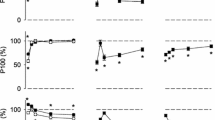Abstract
The force-velocity characteristics of rat medial gastrocnemius muscle have been determined by measuring the force sustained during constant velocity releases of the muscle stimulated in situ at an ambient temperature of 26°C. The velocity of unloaded shortening was determined using the “slack” test and rate of relaxation from the half time of force loss at the end of stimulation. Measurements were first made on fresh muscles using short contractions and then during a series which consisted of a 15 s contraction (fatigued muscle), followed by 15 min recovery and a 1 s contraction (recovered muscle). After a 5 min recovery period the sequence was repeated. Comparison was made between the fatigued and recovered state in each preparation in order to allow for any change in the preparation during the course of the experiment. After 15 s contraction the fatigued muscles showed a marked reduction in all parameters measured. In fatigued muscles the isometric force fell to 48±15% (mean±SD) and there was a decrease in maximum velocity of shortening to 66%. These changes in the force-velocity relationship were accompanied by slowing of relaxation so that the half time of relaxation nearly doubled. The consequence of these changes was that the maximum power output was reduced by a much greater extent that was the isometric force (75% vs. 52%). It is suggested that the changes in force-velocity characteristics reflect a reduction in cross-bridge cycling in fatigued muscle.
Similar content being viewed by others
References
Abbott BC, Aubert XM (1952) The force exerted by active striated muscle during and after change in length. J Physiol 117:77–86
Aubert XM (1956) Le couplage energétique de la contraction musculaire. These d'agregation l'enseignement superieur. Editions Arscia, Brussels
Bigland-Ritchie B, Johansson RS, Lippold ECJ, Woods JJ (1983) Contractile speed and EMG changes during fatigue of sustained maximal voluntary contractions. J Neurophysiol 50:313–324
Claflin DR, Faulkner JA (1985) Shortening velocity extrapolated to zero load and unloaded shortening velocity of whole rat skeletal muscle. J Physiol 359:357–363
Cooke R, Franks K, Luciani GB, Pate E (1988) The inhibition of rabbit skeletal muscle contraction by hydrogen ions and phosphate. J Physiol 395:77–97
Crow MT, Kushmerick MJ (1983) Correlated reduction in velocity of shortening and rate of energy utilization in mouse fast-twitch muscle during a continuous tetanus. J Gen Physiol 82:703–720
Curtin NA, Edman KAP (1987) Force and segment movement during relaxation of frog muscle fibres: effects of fatigue and intracellular acidification. J Physiol 390:153P
Dawson MJ, Gadian DG, Wilkie DR (1980) Mechanical relaxation rate and metabolism studied in fatiguing muscle by phosphorus nuclear magnetic resonance. J Physiol 299:465–484
de Haan A, de Jong J, van Doorn JE, Huijing PA, Woittiez RD, Westra HG (1986) Muscle economy of isometric contractions as a function of stimulation time and relative muscle length. Pflügers Arch 407:445–450
de Haan A, Hollander AP, Sargeant AJ (1988a) A computer-controlled system for isovelocity measurements of in situ rat skeletal muscle. J Physiol 396:8P
de Haan A, Jones DA, Sargeant AJ (1988b) Changes in power output during fatigue of rat medial gastrocnemius muscle. J Physiol 396:77P
Edman KAP (1975) Mechanical deactivation induced by active shortening in isolated muscle fibres of the frog. J Physiol 246:255–275
Edman KAP (1979) The velocity of unloaded shortening and its relation to sarcomere length and isometric force in vertebrate muscle fibres. J Physiol 291:143–159
Edman KAP, Flitney FW (1977) Non-uniform behaviour of sarcomeres during isometric relaxation of skeletal muscle. J Physiol 271:15–16P
Edman KAP, Mattiazzi AR (1981) Effects of fatigue and altered pH on isometric force and velocity of shortening at zero load in frog muscle fibres. J Muscle Res Cell Motil 2:321–334
Edman KAP, Reggiani C (1984) Redistribution of sarcomere length during isometric contraction of frog muscle fibres and its relation to tension creep. J Physiol 351:169–198
Edman KAP, Elzinga G, Noble MIM (1978) Enhancement of mechanical performance by stretch during tetanic, contractions of vertebrate skeletal muscle fibres. J Physiol 281:139–155
Edwards RHT, Hill DK, Jones DA (1975) Metabolic changes associated with the slowing of relaxation in fatigued mouse muscle. J Physiol 251:287–301
Ferenzci MA, Goldman YE, Simmons RM (1984) The dependence of force and shortening velocity on substrate concentration in skinned muscle fibres fromRana temporaria. J Physiol 350: 519–543
Fitts RH, Holloszy JO (1976) Lactate and contractile force in frog muscle during development of fatigue and recovery. Am J Physiol 231:430–433
Hultman E, Sjöholm H (1983) Energy metabolism and contraction force in human skeletal muscle in situ during electrical stimulation. J Physiol 345:525–532
Jones DA (1981) Muscle fatigue due to changes beyond the neuromuscular junction. In: Porter R, Whelan J (eds) Human muscle fatigue: physiological mechanisms. Pitman Medical Publications. Montreal, pp 178–196
Jones DA, Bigland-Ritchie B (1986) Electrical and contractile changes in muscle fatigue. In: Saltin B (ed) Biochemistry of exercise VI. Human Kinetics Publishers, Champaign, Ill, pp 337–392
Maréchal G, Plaghki L (1979) The deficit of the isometric tetanic tension redeveloped after a release of frog muscle at a constant velocity. J Gen Physiol 73:453–467
Sahlin K, Edström L, Sjöholm H (1983) Fatigue and phosphocreatine depletion during carbon dioxide induced acidosis in rat muscle. Am J Physiol 245:C15-C20
Wiles CM, Edwards RHT (1982) Metabolic heat production in isometric ischaemic contractions of human adductor pollicis. Clin Physiol 2:499–512
Author information
Authors and Affiliations
Rights and permissions
About this article
Cite this article
de Haan, A., Jones, D.A. & Sargeant, A.J. Changes in velocity of shortening, power output and relaxation rate during fatigue of rat medial gastrocnemius muscle. Pflugers Arch. 413, 422–428 (1989). https://doi.org/10.1007/BF00584493
Received:
Revised:
Accepted:
Issue Date:
DOI: https://doi.org/10.1007/BF00584493




